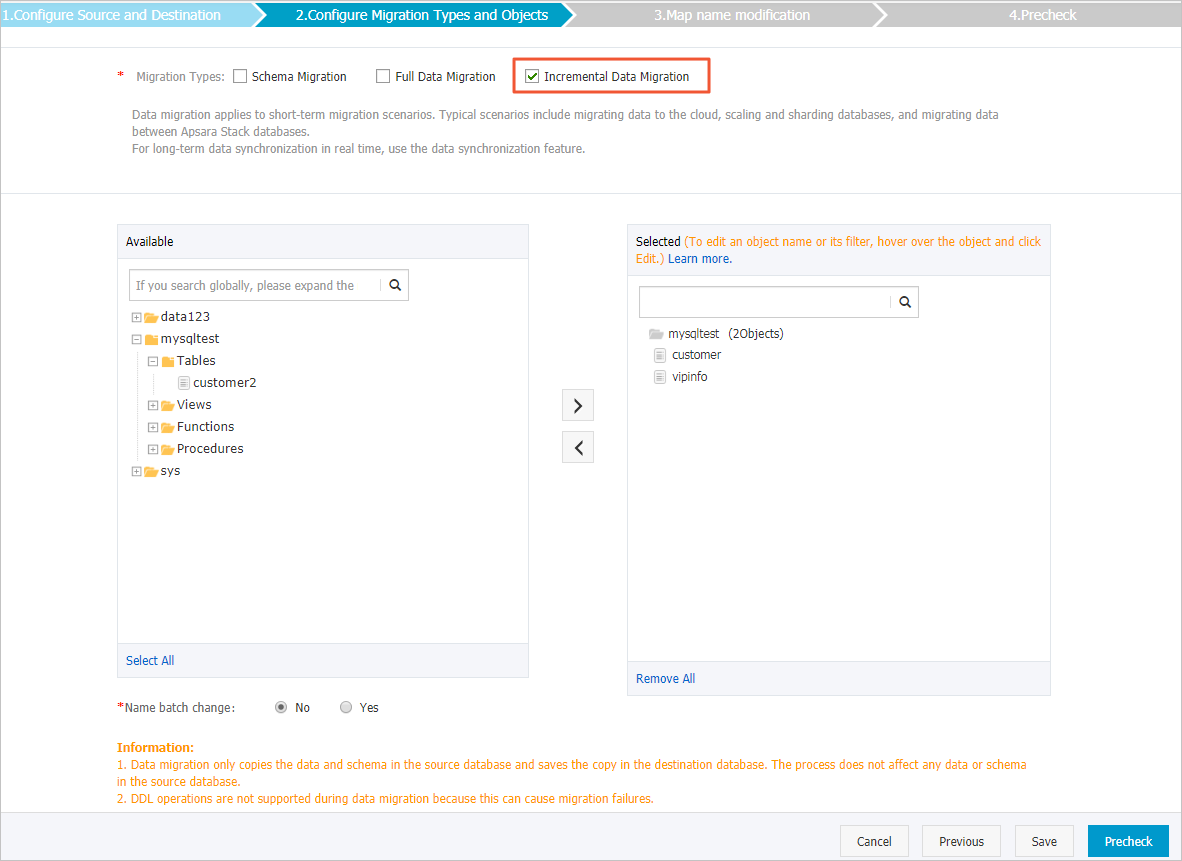This topic describes how to switch your workloads to the destination database and
prepare a rollback solution. This allows you to minimize the negative impact of data
migration on your business.
Usage notes
- We recommend that you switch workloads to the destination database during off-peak
hours to minimize the negative impact. Before you switch workloads to the destination
database, you must stop writing data to the source database and suspend the business.
- We recommend that you create and authorize a database account for data migration.
This allows you to distinguish session information and improve data security.
Procedure
- Wait until the task progress bar shows Incremental Data Migration and The migration task is not delayed or a delay time of less than 5 seconds.

Note The task progress bar shows
Incremental Data Migration only if
Incremental Data Migration is selected when you configure the data migration task. After data is migrated, the
migration task automatically stops. In this case, you must suspend the business and
stop writing data to the source database before you run the data migration task. Go
to Step
5 and proceed.
- Suspend the business and stop writing data to the source database.
- Log on to the source database and run the following statements based on the database
type to view session information. Make sure that no new sessions are used for write
operations.
Note You can run the preceding statements to view the processes or sessions between DTS
and the source database.
- After the status of incremental data migration changes to The migration task is not delayed again, wait for 1 minute or longer, and then manually stop the migration task.
Warning After the data migration task is stopped, do not start the task unless necessary.
Otherwise, the migrated data may be inconsistent with the original data.

- When the business is still suspended, remove the limit on writing data to the source
database.
- Create and start a task to migrate incremental data generated in the destination database
to the source database. The migration task created in this step provides a rollback
solution. If an error occurs in the destination database, you can switch workloads
to the source database.
For example, if the original migration task is used to migrate data from a self-managed
MySQL database to an ApsaraDB RDS for MySQL instance, you need to create a migration
task to migrate data from the ApsaraDB RDS for MySQL instance to the self-managed
MySQL database in this step. For more information, see Migrate data from an ApsaraDB RDS for MySQL instance to a self-managed MySQL database. When you create the migration task in the opposite direction, select only Incremental Data Migration.
Warning When you configure a data migration task in the opposite direction, you must select
only Incremental Data Migration in the Configure Migration Types and Objects step. Then, you must select the database or table to be migrated back to the source
database.

- Switch workloads to the destination database and manually terminate or release the
data migration task.
- After you run the task in the opposite direction, incremental data generated in the
destination database is migrated back to the source database in real time. If the
business fails, you can switch workloads back to the source database.
What to do next
After you switch workloads to the destination database and test all the business-related
features, you can stop the task in the opposite direction. For more information, see
Stop a data migration task.
Warning The database accounts that are used for data migration have the read and write permissions.
After data is migrated, you must delete the accounts or revoke the write permissions
to ensure security.
FAQ
- Q: What do I do if an error occurs after I switch workloads to the destination database?
A: If an error occurs, you can switch workloads back to the source database. After
you run the task in the opposite direction, incremental data generated in the destination
database is migrated back to the source database in real time.
- Q: How do I ensure that data in the source database is consistent with that before
the switchover if workloads fail to be migrated to the destination database?
A: You can back up the source database before you switch workloads. If the workloads
fail to be switched to the destination database, you can restore the source database
to ensure data consistency.
- Q: What do I do if data is written to the source database due to a misoperation after
I switch workloads to the destination database?
A: You can use the data verification feature to compare the data of the source and
destination databases. Then, you can make changes to ensure data consistency.


